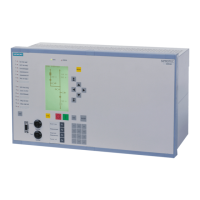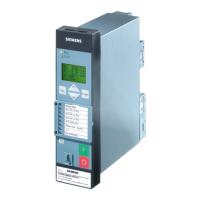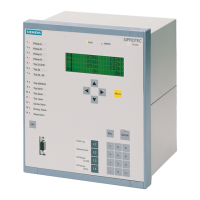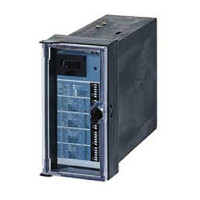If the voltage transformer set provides open delta windings and if these windings are connected to the device,
this must be specified accordingly in address 213 (see above margin heading “Voltage Connection”). Since the
voltage transformer ratio is normally as follows:
[uebersetzung-spannungswandler-020313-kn, 1, en_US]
the factor V
ph
/V
N
(secondary voltage, address 206 Vph / Vdelta) must be set to 3/ √3 = √3 = 1.73 which
must be used if the VN voltage is connected. For other transformation ratios, i.e. the formation of the
displacement voltage via an interconnected transformer set, the factor must be corrected accordingly.
Please take into consideration that also the calculated secondary V
0
-voltage is divided by the value set in
address 206. Thus, even if the V
0
-voltage is not connected, address 206 has an impact on the secondary
operational measured value V
N
.
Trip and Close Command Duration (Breaker)
In address 210 the minimum trip command duration TMin TRIP CMD is set. This setting applies to all protec-
tion functions that can initiate tripping.
In address 211 the maximum close command duration TMax CLOSE CMD is set. It applies to the integrated
reclosing function. It must be set long enough to ensure that the circuit breaker has securely closed. An exces-
sive duration causes no problem since the closing command is interrupted in the event another trip is initiated
by a protection function.
Current Flow Monitoring (Breaker)
In address 212 BkrClosed I MIN the pickup threshold of the integrated current flow monitoring function
can be set. This parameter is used by several protection functions (e.g. voltage protection with current crite-
rion, overload protection, load jam protection, restart inhibit for motors and circuit breaker maintenance). If
the set current value is exceeded, the circuit breaker is considered closed.
The threshold value setting applies to all three phases, and must take into consideration all used protection
functions.
The pickup threshold for the breaker failure protection is set separately (see 2.18.2 Setting Notes).
When using the device as motor protection and using the overload protection, load jam protection and restart
inhibit, the protective relay can distinguish between a running motor and a stopped motor, as well as take into
account the different motor cooldown behavior. For this application, the set value must be lower than the
minimum no-load current of the motor.
Circuit-breaker Maintenance (Breaker)
Parameters 260 to 267 are assigned to CB maintenance. The parameters and the different procedures are
explained in the setting notes of this function (see Section 2.25.2 Statistics).
Two-phase Time Overcurrent Protection (Protection Operating Quantities)
The two-phase overcurrent protection functionality is used in grounded or compensated systems where inter-
action of three-phase devices with existing two-phase protection equipment is required. Via parameter 250
50/51 2-ph prot the time overcurrent protection can be configured to two or three-phase operation. If the
parameter is set to ON, the value 0 A instead of the measured value for Ι
B
is used permanently for the
threshold comparison so that no pickup is possible in phase B. All other functions, however, operate in three
phases.
Ground Fault Protection (Protection Operating Quantities)
Parameter 613 50N/51N/67N w. defines whether ground fault protection, breaker failure protection or Fuse
Failure Monitor is either to operate using measured values (Ignd (measured))) or the quantities calculated
from the three phase currents (3I0 (calcul.)). In the first case, the measured quantity at the fourth
current input is evaluated. In the latter case, the summation current is calculated from the three phase current
Functions
2.1 General
SIPROTEC 4, 7SJ62/64, Manual 45
C53000-G1140-C207-8, Edition 08.2016

